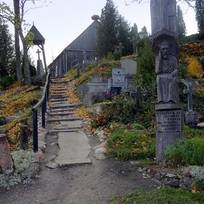Archaeologists have established that the Raktė or Raktuvė, hillfort dates back to two periods. The first human occupation (from the earliest finds of a bone pin sherd and striated pottery) dates back to the Late Brass Age and Early Stone Age (1000-1 BC). At that time, the hillfort had a settlement of cattle breeders. In the second period (throwing pottery, stone moulding plate), in the 10th century, it was inhabited by the Semigallians. A castle was then built on the hill and in addition to defence it, crafts and other businesses flourished. The hillfort is about 95 m long and 43 m wide, the site is quadrangular, elongated, and the slopes are 6–7 m high. The hillfort has been badly disturbed since the mid-19th century by the burial of the dead and the construction of a wooden chapel in the centre of the site. Various archaeological finds have been discovered on the site. The most impressive are a stone mould for casting pewter jewellery (one of 11 sites in Lithuania) and a bone plate with inscribed circles and scored pits – perhaps the only find of such kind.

+1



Reviews